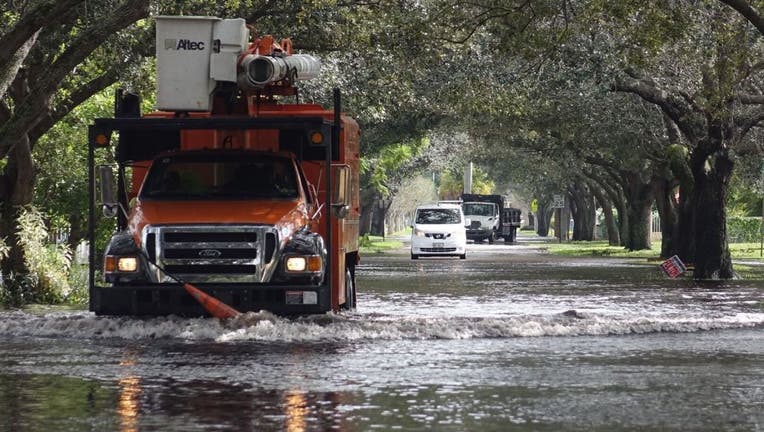DeSantis expands emergency for 'erratic' storm Eta

Flooding in Plantation just north of Broward Blvd. in the area of NW 46th Ave. on Monday, November 9, 2020. (Joe Cavaretta/South Florida Sun-Sentinel/Tribune News Service via Getty Images)
TALLAHASSEE, Fla. - Pointing to the “erratic nature” of the storm as it threatened a large part of Florida’s west coast, Gov. Ron DeSantis on Wednesday expanded a state of emergency and asked President Donald Trump for a federal emergency declaration as Tropical Storm Eta prepared to make landfall Thursday.
Tropical-storm and storm-surge warnings and a hurricane watch were in effect Wednesday for much of the state’s west coast, including the Tampa metropolitan area. The National Hurricane Center said in a 1 p.m. advisory that the storm was expected to remain offshore Wednesday before making landfall Thursday and then crossing the state into the Atlantic.
In the request to Trump, DeSantis cited risks of flooding and potential complications in sheltering people because of COVID-19. The hurricane center advisory said tropical-storm and storm-surge warnings were in effect from Bonita Beach in Southwest Florida to the Suwannee River in northern Florida. A hurricane watch was in effect from Ana Maria Island to Yankeetown.
“These areas along the west coast of Florida are the most vulnerable areas to storm surge in the entire state and prone to long duration coastal flooding that could lead to evacuations of coastal populations,” DeSantis wrote in the 10-page request.
Featured
County by county: Tropical Storm Eta emergency information
Tropical Storm Eta is forecast to pass close to the Tampa Bay area, making landfall along the state’s west coast. The Tampa Bay area is under a hurricane watch and several local counties are issuing emergency orders.
DeSantis also said that medical evacuations and special-needs operations “are complicated by the additional safety requirements required as a result of COVID-19.”
“Emergency protective measures required as a result of this event will require extraordinary efforts of state and local government,” DeSantis’ request said. “With thousands of our citizens fighting COVID-19, we anticipate the need for shelters to be greater than usual, which results in increased resource requirements. Even healthy populations sheltered in traditional congregate shelters will require PPE (personal protective equipment) and the implementation of mitigation measures against the spread of COVID-19 in such environments. Special needs shelters and isolation facilities will be used in greater numbers than for previous events due to the prevalence of COVID-19 in the state.”
LINK: Track Eta on MyFoxHurricane.com
DeSantis made the request when Eta was at hurricane strength, but the hurricane center said in the 1 p.m. advisory that the system had weakened to a tropical storm. It was about 115 miles southwest of Tampa, with maximum sustained winds of 70 mph.
The governor on Saturday declared a state of emergency for counties in the southern part of the state, after Eta last week hit Nicaragua as a hurricane. Eta deluged parts of South Florida and then has lingered in the Gulf of Mexico, with a series of changes in its forecast track.
Featured
Eta back down to a tropical storm, but severe weather continues across Tampa Bay area
Tropical Storm Eta strengthened to a Category 1 hurricane Wednesday morning as it began to skirt the west coast of Florida, but has since weakened slightly as it moved closer to the Tampa Bay area.
With the forecast Wednesday for the storm to hit the west coast and cross the state, DeSantis expanded the executive order to include Alachua, Citrus, Dixie, Gilchrist, Hernando, Hillsborough, Levy, Manatee, Marion, Pasco, Pinellas, Sarasota and Sumter Counties. In the request to Trump, which could bring federal financial assistance to Florida, DeSantis said some counties also had declared local states of emergency.
LINK: Track Eta on MyFoxHurricane.com
“The erratic nature of this tropical event is complicating evacuation and sheltering efforts and there are other counties discussing such a declaration and planning for the implementation of emergency protective measures, including the use of non-congregate sheltering,” the request said. “While a staple of this hurricane season, the lead time required to (successfully) execute these operations is complex by the lack of a clear track and intensity forecasts from the National Hurricane Center.”
A “cone” of the projected path of the storm showed it making landfall about 7 a.m. Thursday north of Tampa and exiting Florida about 7 p.m. Thursday in the northeast corner of the state.



